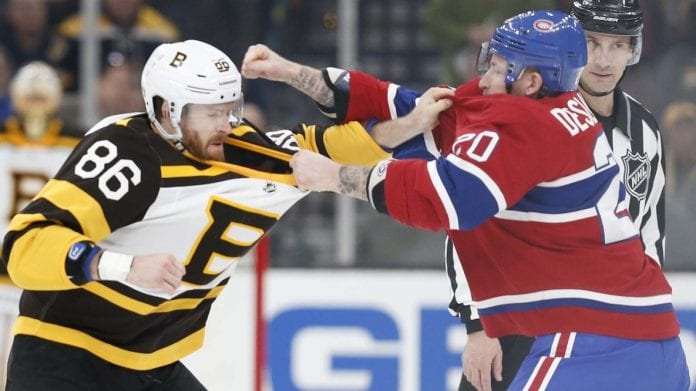
by Cate Racher, Staff Writer/Copy Editor, All Habs Hockey Magazine
Whenever I talk to anyone about hockey, or hear anything about hockey, one of the first things that usually comes up is the biggest and best hockey fights from that week. We see it happen to varying degrees in almost every game that is played during both the pre-season and the regular season.
Recently, a short Radio-Canada produced documentary (in English) was brought to my attention by our editor-in-chief, Rick Stephens, because he knows I have an interest in concussions in hockey.
This documentary details the cautionary tale of Connor Crisp, who was drafted 71st overall in the third round by the Montreal Canadiens. Crisp went on to play 17 games for the St. John’s IceCaps over the course of two seasons, but those seasons saw Crisp plagued by concussion symptoms that would ultimately end his hockey playing career.
Over the course of his time playing hockey, Crisp suffered approximately seven or eight concussions. In 2015, during the early days of his time with the IceCaps, Crisp suffered a concussion that occurred during a fight with Derek Mathers of the Lehigh Valley Phantoms. He claims it is the only concussion he ever received during a fight, but it is that same concussion that he thinks eventually ended his career before he turned 24.
Hockey is, by nature, an extremely physical and sometimes violent sport. This is something that everyone who follows hockey knows, understands, and has come to accept and even enjoy. But why is it that something that is constantly sending players off the ice, sometimes on a stretcher, just an acceptable part of the game?
Crisp played a good game. The middle of his hockey playing career saw 22 and 28 goals respectively in the 2012-’13 and 2013-’14 seasons, and in his final season playing hockey he scored 16 goals and 14 assists. With some development and training, he could have transitioned from a decent AHL and ECHL player into a solid NHL player. But due to his concussions, he never even got the chance.
Fighting is as much a part of hockey culture as a team’s jersey or mascot. Both Bobby Orr and Jarome Iginla have stated in recent years that fighting has an important place on the ice because it holds players accountable for their actions and shows them that there is a price to pay for targeting star players on either team. Some say that fighting serves as a calming effect for their teams and that it brought the players together.
Bobby Smith, the majority owner of Halifax Mooseheads, even posited that eliminating fighting from hockey would not be common sense and that it would likely lead to a drastic increase in concussions and to reckless and dangerous behaviour displayed on the ice. Unfortunately it is a sentiment that has been echoed by both former and current NHL players.
When I asked my followers on Twitter their opinions on fighting in hockey, most of the responses echoed the fact that fighting was safer than the alternative of taking revenge through more dangerous and illegal hits.
Yes, there needs to be better safeguards in place to protect players (such as adding cages to helmets, padding in uniforms, and regulations to make head hits illegal), but it makes the sport more entertaining for a lot of people. The players make the decision to fight, and fighting has always been a part of the sport, so they see no reason to ban it.
I agree with a lot of what they said, but I really don’t think that banning fighting would change the fundamental nature of the sport. In fact, it may just make it look more like how games are played in Europe or how they play hockey during the Olympics, where there is no fighting allowed. It wouldn’t make the sport any less entertaining, it would just make it safer for the players and would likely result in fewer career ending injuries like the one that happened to Connor Crisp.
Of course there are rules, and fighting may not be as prevalent as it used to be when, say, Maurice Richard was playing, but the injuries that these players obtain while fighting are so needless in a sport that is already very physically intense.
According to this 2013 study, fighting may not result in as many concussions as getting hit by a puck or illegal hits such as bodychecking, but the fact that fighting is even a small part of that concerns me immensely, especially after learning more about Connor Crisp and his love of fighting.
I’ve seen the argument that it is natural for men to be more aggressive and to want to fight to settle any grievances that they may have in an environment that is already extremely physically competitive. It’s just “boys being boys”. But fighting on the ice can not and should not be dismissed anymore as just something that men do, especially when there are no real safeguards to prevent moderate to severe injuries.
Every time there is a fight on the ice, it just increases the risk of players obtaining concussions or severe injuries that could end their careers just like Crisp. And while he has said that he doesn’t regret the type of game he played, he would give just about anything to feel normal again.
I don’t see the NHL outlawing fighting anytime soon, since it is such a draw for so many people and because there are still so many players, both old and new, who think it plays an important role in the game.
However, Crisp’s story does bring up an interesting debate that definitely needs to take place around fighting’s place in the sport, especially as it pertains to head injuries that have the potential to end a player’s career. And I think a very important part of that is going to be how much more they are willing to excuse or brush off before someone gets seriously injured or killed on the ice as the result of fighting.








![Prospect Report: Habs Development Camp Testing [GALLERY]](https://habshockeyreport.com/wp-content/uploads/2014/07/IMG_2897.jpg)

![Habs Western Road Trip in Pictures [GALLERY]](https://habshockeyreport.com/wp-content/uploads/2014/03/476898185_slide.jpg)